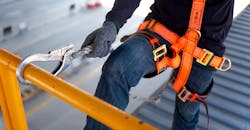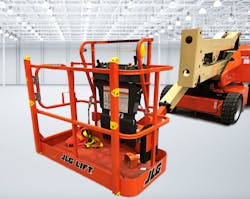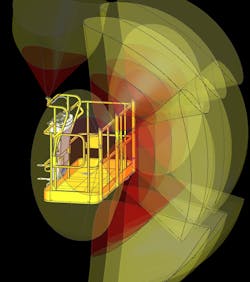Refining how workers maneuver aerial work platforms (AWPs) around structures is something the access industry continuously works at. These innovations have resulted in more precise, proportional controls and the adoption of familiar and mature operator awareness systems.
Previously, the access industry saw the development of soft touch detection systems from several aerial work platform manufacturers that aid operators in reducing costly damages to structures on the jobsite. These systems use mechanical limit switches to stop machine functions once it has contacted a structure. The switches are activated by an oversized padded frame that is suspended underneath the work platform or poles above the work area with limit switch whiskers.
The JLG Enhanced Detection System (EDS) expands upon the JLG Soft Touch System, notifying of approaching obstructions and stopping functions before the machine makes contact.
Following the advancement of sensors in the automotive industry, aerial work platform manufacturers are continuing to evolve an even better solution for contractors that will enhance the operator’s awareness of their surroundings.
When mounted on an aerial work platform, advancing enhanced detection systems use progressive ultrasonic technology to detect the presence of a nearby objects. The system alerts operators to the object’s presence with audible and visual warnings while simultaneously slowing, then stopping, the machine before it comes in contact with an object.
Many aerial work platforms work near sensitive structures that must not be damaged by contact with the platform. If damage were to occur, it would likely cause substantial and costly project delays. An enhanced detection system is perfect for use in specialized industrial applications where the maintenance of structures requires extra care, and sensitive materials must not contact any type of machine that could make even a slight dent or abrasion on them.
Selecting the Best Sensor
We have seen and experienced the rapid increased use of sensor technology across the automotive industry. While there are multiple sensor technologies available today, each comes with certain limitations. When developing an EDS for aerial work platforms, it is crucial to use sensor technology that will provide the best coverage of the desired area. There are several types of sensors that can be considered for enhanced detections systems, including:
- Ultrasonic sensors
- Radar
- Light-based radar sensors
Ultrasonic sensors function by producing a burst of sound waves in very rapid succession. When these sound waves then hit a target, the sound wave is reflected to the sensor. Because the sound wave travels at a known speed (the speed of sound), the travel time of the signal can be measured, and an operating system can calculate the distance between the sensor and the target.
Radar, by contrast, works not with sound waves but with electromagnetic waves; this is the main difference between the two sensors. Processing similarly to ultrasonic sensors, the waves emitted bounce off an object traveling at a known speed.
Based on the current state of sensor technology, ultrasonic sensors are the most ideal for aerial work platforms and have been widely adopted within the automotive industry for similar applications. In addition, the durability and familiarity of these systems also lend themselves to intuitive adoption on the jobsites. Light-based radar sensors provide a more 2D fan style sensing area where ultrasonic sensors offer a cone shaped coverage area creating a greater range of detection for a work platform, especially behind the operator.
Sensor Placement on the Platform
Determining the best placement of sensors on the work platform is crucial to creating an effective enhanced detection system. Sensors need to provide coverage across the work platform without detecting the operator’s movements and falsely slowing down and or stopping the machine functions. The work platform structure itself is another obstacle that needs to be kept out of the line of the sensors without taking away from the coverage. Effective placement and orientation of the sensors becomes extremely challenging. Accommodating existing fleets as well as new equipment only exacerbates this challenge of getting the technology integrated into today’s jobsites.
Sensors and retainers are affixed to the tubes and knobs allow for sensor angle adjustment.
The packaging of the sensors also plays a significant role in the placement of the sensors on the work platform. Sensors and retainers are affixed to structures with sometimes multiple sensors each depending on the level of coverage desired. Boom lifts offer a level one enhanced detection system which has eight sensors, or a higher-coverage level two system that has 12 sensors across the work platform. Scissor lifts also come with the option of two levels of coverage—level one with four sensors or level two with eight sensors. Designed with the need for multiple operators in mind, certain sensors can be adjusted based on each operator, creating the most efficient and effective coverage possible.
Establishing Warning Zones
Some systems have a sensor detection area with warning and stop zones established. A system with this capability can give the operator visual and audible notifications of an approaching object and slow the machine’s operation. Additional features may include the ability to minimize unwanted detections. Adaptive warning zones can change the size based on the machine’s speed. For example, traveling at full speed the warning zone increases, whereas at only 50% speed, the warning zone is decreased.
The yellow cone sections represent the warning zones while the red cone sections begin the stop zone.
The aerial work platform is automatically placed in creep mode as the operator enters the warning zone. This function helps the operator to recognize and avoid possible hazards before coming close to them. Once enacted, the warning zone is not latched, meaning that the control system allows for return to normal boom function speed without operator intervention as soon as sensors report the aerial work platform is safely out of the warning zone. Once the object enters the stop zone, operation is stopped. The operator is free to move away from the object after cycling the footswitch. However, if the operator intends to move closer to the object, they must activate the override function.
Enhanced Detection System
Following the automotive industry’s expanding adoption of sensor-based systems for operator awareness, machine control and autonomy, the demand for similar enhanced detection systems on aerial work platforms is growing. With the introduction of enhanced detection systems in the access industry, operators will have increased confidence maneuvering boom and scissor lifts on the job.
This technology will advance. For example, there will be an optional JLG Enhanced Detection System expected to be available for purchase with two levels of coverage on select model boom and scissor lifts by mid-2019. Thereafter this technology will be phased into production on booms and scissors.
Fredric Yutzy is a senior project engineer with JLG Industries. In this role, he is responsible for leading a team focused on delivering innovative solutions for use on existing JLG product lines. His team focuses on developing new options and accessories to enhance the operator’s experience and confidence while working or handling material at height. Fredric has been with JLG Industries for over 4 years and has over 14 years of new product design experience.
About the Author
Fredric Yutzy
Fredric Yutzy is a senior project engineer with JLG Industries. In this role, he is responsible for leading a team focused on delivering innovative solutions for use on existing JLG product lines. His team focuses on developing new options and accessories to enhance the operator’s experience and confidence while working or handling material at height. Fredric has been with JLG Industries for more than years and has o14 years of new product design experience.




